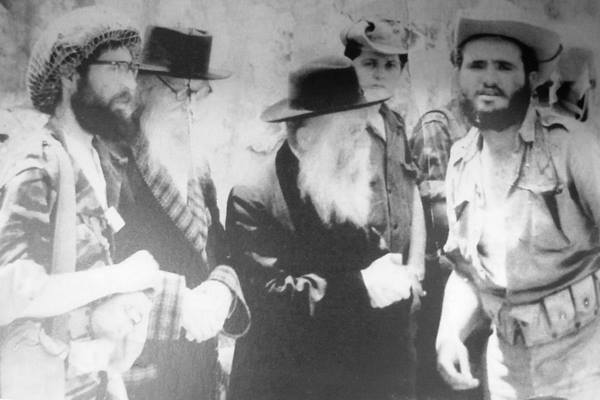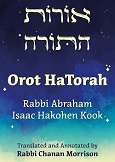
In a sense, it all started in the fall of 1966. During the annual memorial for Rav Kook on the third of Elul, Rav Tzvi Yehudah surprised the people gathered at Beit HaRav with an unusual statement. “My father labored for the sake of the Jewish people when he was alive in this world,” he said. “And he continues to work for the Jewish people, with even greater strength and merit, while in the next world.”
These labors, Rav Tzvi Yehudah noted, are connected to the Jewish people’s possession of Eretz Yisrael. Especially this year:
“As his stay in the next world lengthens, so his power and influence grow. Each year, he conquers an additional realm in the “yeshiva on high,” and these conquests continue and spread. This year is the 31st year since his passing [in 1935]. The number of conquests is thus 31 — corresponding to the number of Canaanite kings that Joshua subdued [when conquering the Land of Israel].”
The following spring, the security situation in Israel deteriorated rapidly. Egypt expelled UN peacekeeping forces in the Sinai Peninsula and began massing troops on Israel’s border. On May 22, Egypt blocked the Straits of Tiran, passageway for almost all of Israel’s oil. The following week, Egypt and Jordan signed a defense pact, posing a further threat to the young country. (Syria had signed a mutual defense agreement the previous November.) And the Iraqi army deployed troops and armored units in Jordan.
In Israel, spirits were low and tensions high.
During Israel Independence Day celebrations at the Mercaz HaRav yeshiva, Rav Tzvi Yehudah usually spoke about the spiritual significance of the day. But this year, the nineteenth year of the State of Israel, his address took on a different tone. It was less of a lecture and more of a prophetic vision.
Rav Tzvi Yehudah recalled his visceral pain nineteen years previous, when the 1947 UN Partition Plan was approved, assigning parts of the Jewish homeland to an Arab state. People streamed into the streets to celebrate and rejoice.
“But I could not go out and join in the celebration. I sat alone and silent; a heavy burden lay upon me. During those first hours, I could not resign myself to what had been done. I could not accept the fact that, indeed, “They have divided My land” (Joel 4:2).”
The rabbi then stunned the audience as he thundered,
“And where is our Hebron? Are we forgetting this? Where is our Shechem, our Jericho? Have we forgotten them?”
Rabbi Hanan Porat, well-known author, educator, and member of Knesset, was one of the Mercaz HaRav students who fought in the battle for Jerusalem. “I was in the yeshiva during that Independence Day celebration,” Rabbi Porat recalled. “Rav Tzvi Yehudah’s roars still reverberate in my ears. If I think back to lectures or speeches that influenced me, without a doubt it was this address that had the greatest impact on me.”
He added, “We felt that our rabbi was speaking with prophetic spirit, that ‘the Shechinah was speaking though his mouth.’ The very walls shook. People looked at one other in wonder.”
The Liberation of Jerusalem
Rabbi Israel Ariel, another student of Mercaz HaRav who participated in the liberation of Jerusalem, shared his story, which began soon after that momentous address in the yeshiva.
When they announced preparations [of the reserve army] before the Six-Day Way, I was called up as a paratrooper. For three weeks, we waited in orchards near the Lod airport, ready to parachute into the Sinai Desert.
During these weeks of waiting, many thoughts passed in my head. What was the meaning of this war? Ten years earlier, the Sinai War had been fought, at the price of many lives. And in the end, nothing had been gained from it. What was the point of another war and the further spilling of precious blood?
I wrote my questions in a letter to Rav Tzvi Yehudah and the Rav HaNazir. But before I had a chance to mail my letter, the war broke out. Our division, under the command of Motta Gur, was reassigned to Jerusalem. With God’s mercy, we had the privilege of liberating the Old City and the Temple Mount.
As we made our way to the Temple Mount, it was rumored that two elders from Jerusalem had arrived. I was overcome with powerful emotions and an unbelievable feeling of elation. I was sure that these two elders must be the Messiah and Elijah the prophet....
When I descended from the Temple Mount to the Kotel, I discovered that the two elders were none other than our master, Rav Tzvi Yehudah, and the Rav HaNazir. We hugged, we kissed, and our tears flowed without stop....
I realized then that I had received the answer to my questions — directly from Rav Tzvi Yehudah and the Rav HaNazir. We had merited seeing, with our own eyes, God’s return to Zion!
Rabbi Hanan Porat related his memories from the war:
On the fourth day of the war, we fought at Ammunition Hill. From there we went up to Mount Scopus and the Agusta Victoria hospital. We started making our way toward the Temple Mount. Suddenly — I couldn’t believe my eyes — an army jeep passed by us, carrying Rav Tzvi Yehudah and the Rav HaNazir! They were wearing steel helmets, and the Rav HaNazir’s long hair streamed out in the wind....
It was an otherworldly sight. The fact that these two holy scholars were among the first ones to reach the Kotel added another level of holiness to our return to the Kotel.
Rabbi Porat recalled how Rav Tzvi Yehudah cleaved to the stones of the Kotel. He prayed with intense fervor; and afterward, he turned to the soldiers and kissed them. The Rav HaNazir, on the other hand, cleaved to the Kotel and never let go. He was soaring in elevated realms. This was typical of these two great figures; each one expressed himself in his own individual spiritual path.
The Soldier’s Reward
The next day, several of Rav Tzvi Yehudah’s students went to visit their master. They found Rav Tzvi Yehudah visiting the Rav HaNazir in his Jerusalem apartment. The two scholars were discussing the momentous events of the previous day.
“Around eleven o'clock in the morning,” Rav Tzvi Yehudah told the students, “an army officer knocked on my door. He told me that Rabbi Goren, the IDF Chief Rabbi, had invited me to come immediately to the Kotel. A jeep was waiting for me in the street.”
The rabbi entered the vehicle, where he was joined by the Rav HaNazir (who was the father-in-law of Rabbi Goren). On the way to the Kotel, the officer told them the following story:
When the paratroopers arrived at the Kotel, one of the soldiers — a student at Mercaz HaRav — climbed up to the highest row of stones and waved the flag of Israel. Down below, the paratroopers shouted and cheered. The commander announced that the soldier deserved a prize for his action, and asked him what he wanted.
In the silence that followed, the soldier thought for a moment and replied, “The greatest prize for me would be to bring Rav Tzvi Yehudah Kook, the head of the Mercaz HaRav yeshiva, so that he will join us in our great joy.”
The Rav HaNazir then startled those present with his account of the visit to the Kotel. “As we approached the Kotel, I saw Rav Kook, of blessed memory, standing there, wearing his Sabbath clothes.” Surprised by the looks of confusion on the students’ faces, he said, “But of course the Rav had to be there on that special day!
(Stories from the Land of Israel. Mashmia Yeshu'ah, pp. 327-334.)





